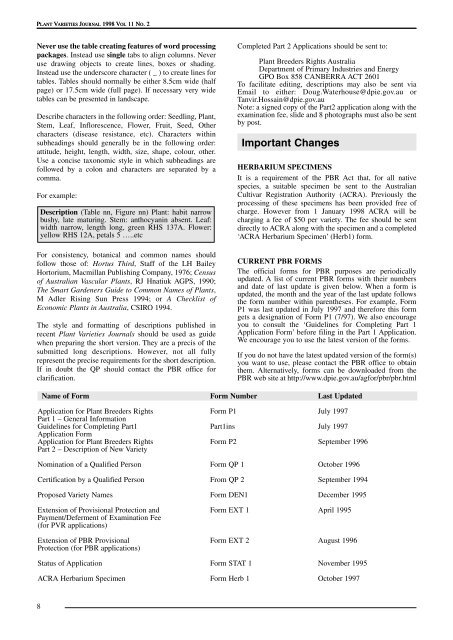60. Volume 11- Number 2 - IP Australia
60. Volume 11- Number 2 - IP Australia
60. Volume 11- Number 2 - IP Australia
You also want an ePaper? Increase the reach of your titles
YUMPU automatically turns print PDFs into web optimized ePapers that Google loves.
PLANT VARIETIES JOURNAL 1998 VOL <strong>11</strong> NO. 2<br />
Never use the table creating features of word processing<br />
packages. Instead use single tabs to align columns. Never<br />
use drawing objects to create lines, boxes or shading.<br />
Instead use the underscore character ( _ ) to create lines for<br />
tables. Tables should normally be either 8.5cm wide (half<br />
page) or 17.5cm wide (full page). If necessary very wide<br />
tables can be presented in landscape.<br />
Describe characters in the following order: Seedling, Plant,<br />
Stem, Leaf, Inflorescence, Flower, Fruit, Seed, Other<br />
characters (disease resistance, etc). Characters within<br />
subheadings should generally be in the following order:<br />
attitude, height, length, width, size, shape, colour, other.<br />
Use a concise taxonomic style in which subheadings are<br />
followed by a colon and characters are separated by a<br />
comma.<br />
For example:<br />
Description (Table nn, Figure nn) Plant: habit narrow<br />
bushy, late maturing. Stem: anthocyanin absent. Leaf:<br />
width narrow, length long, green RHS 137A. Flower:<br />
yellow RHS 12A, petals 5 …..etc<br />
For consistency, botanical and common names should<br />
follow those of: Hortus Third, Staff of the LH Bailey<br />
Hortorium, Macmillan Publishing Company, 1976; Census<br />
of <strong>Australia</strong>n Vascular Plants, RJ Hnatiuk AGPS, 1990;<br />
The Smart Gardeners Guide to Common Names of Plants,<br />
M Adler Rising Sun Press 1994; or A Checklist of<br />
Economic Plants in <strong>Australia</strong>, CSIRO 1994.<br />
The style and formatting of descriptions published in<br />
recent Plant Varieties Journals should be used as guide<br />
when preparing the short version. They are a precis of the<br />
submitted long descriptions. However, not all fully<br />
represent the precise requirements for the short description.<br />
If in doubt the QP should contact the PBR office for<br />
clarification.<br />
Completed Part 2 Applications should be sent to:<br />
Plant Breeders Rights <strong>Australia</strong><br />
Department of Primary Industries and Energy<br />
GPO Box 858 CANBERRA ACT 2601<br />
To facilitate editing, descriptions may also be sent via<br />
Email to either: Doug.Waterhouse@dpie.gov.au or<br />
Tanvir.Hossain@dpie.gov.au<br />
Note: a signed copy of the Part2 application along with the<br />
examination fee, slide and 8 photographs must also be sent<br />
by post.<br />
Important Changes<br />
HERBARIUM SPECIMENS<br />
It is a requirement of the PBR Act that, for all native<br />
species, a suitable specimen be sent to the <strong>Australia</strong>n<br />
Cultivar Registration Authority (ACRA). Previously the<br />
processing of these specimens has been provided free of<br />
charge. However from 1 January 1998 ACRA will be<br />
charging a fee of $50 per variety. The fee should be sent<br />
directly to ACRA along with the specimen and a completed<br />
‘ACRA Herbarium Specimen’ (Herb1) form.<br />
CURRENT PBR FORMS<br />
The official forms for PBR purposes are periodically<br />
updated. A list of current PBR forms with their numbers<br />
and date of last update is given below. When a form is<br />
updated, the month and the year of the last update follows<br />
the form number within parentheses. For example, Form<br />
P1 was last updated in July 1997 and therefore this form<br />
gets a designation of Form P1 (7/97). We also encourage<br />
you to consult the ‘Guidelines for Completing Part 1<br />
Application Form’ before filing in the Part 1 Application.<br />
We encourage you to use the latest version of the forms.<br />
If you do not have the latest updated version of the form(s)<br />
you want to use, please contact the PBR office to obtain<br />
them. Alternatively, forms can be downloaded from the<br />
PBR web site at http://www.dpie.gov.au/agfor/pbr/pbr.html<br />
Name of Form Form <strong>Number</strong> Last Updated<br />
Application for Plant Breeders Rights Form P1 July 1997<br />
Part 1 – General Information<br />
Guidelines for Completing Part1 Part1ins July 1997<br />
Application Form<br />
Application for Plant Breeders Rights Form P2 September 1996<br />
Part 2 – Description of New Variety<br />
Nomination of a Qualified Person Form QP 1 October 1996<br />
Certification by a Qualified Person From QP 2 September 1994<br />
Proposed Variety Names Form DEN1 December 1995<br />
Extension of Provisional Protection and Form EXT 1 April 1995<br />
Payment/Deferment of Examination Fee<br />
(for PVR applications)<br />
Extension of PBR Provisional Form EXT 2 August 1996<br />
Protection (for PBR applications)<br />
Status of Application Form STAT 1 November 1995<br />
ACRA Herbarium Specimen Form Herb 1 October 1997<br />
8

















